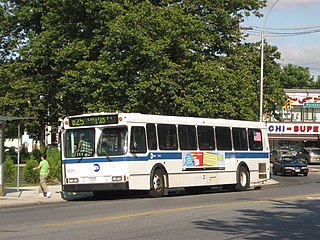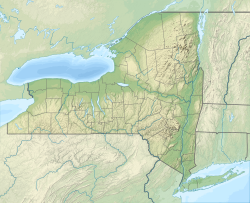
Flushing is a neighborhood in the north-central portion of the New York City borough of Queens. The neighborhood is the fourth-largest central business district in New York City. Downtown Flushing is a major commercial and retail area, and the intersection of Main Street and Roosevelt Avenue at its core is the third-busiest in New York City, behind Times Square and Herald Square.

Fresh Meadows is a neighborhood in the northeastern section of the New York City borough of Queens. Fresh Meadows used to be part of the broader town of Flushing and is bordered to the north by the Horace Harding Expressway; to the west by Pomonok, St. John's University and the sub-neighborhoods of Hillcrest and Utopia; to the east by Cunningham Park and the Clearview Expressway; and to the south by the Grand Central Parkway.

Queens Botanical Garden is a botanical garden located at 43-50 Main Street in Flushing, Queens, New York City. The 39-acre (16 ha) site features rose, bee, herb, wedding, and perennial gardens; an arboretum; an art gallery; and a LEED-certified Visitor & Administration Building. Queens Botanical Garden is located on property owned by the City of New York, and is funded from several public and private sources. It is operated by Queens Botanical Garden Society, Inc.

Kew Gardens Hills is a neighborhood in the middle of the New York City borough of Queens. The borders are Flushing Meadows-Corona Park to the west, the Long Island Expressway to the north, Union Turnpike to the south, and Parsons Boulevard to the east.

Pomonok is a working class neighborhood in the New York City borough of Queens. This large public housing development in South Flushing was built in 1949 on the former site of Pomonok Country Club. The name comes from a Native American word for eastern Long Island, and means either "land of tribute" or "land where there is travelling by water".

Kissena Park is a 235-acre (95 ha) park located in the neighborhood of Flushing in Queens, New York City. It is located along the subterranean Kissena Creek, which flows into the Flushing River. It is bordered on the west by Kissena Boulevard; on the north by Rose, Oak, Underhill, and Lithonia Avenues; on the east by Fresh Meadow Lane; and on the south by Booth Memorial Avenue. The park contains the city's only remaining velodrome, a lake of the same name, two war memorials, and various playgrounds and sports fields.

The Flushing River, also known as Flushing Creek, is a waterway that flows northward through the borough of Queens in New York City, mostly within Flushing Meadows–Corona Park, emptying into the Flushing Bay and the East River. The river runs through a valley that may have been a larger riverbed before the last Ice Age, and it divides Queens into western and eastern halves. Until the 20th century, the Flushing Creek was fed by three tributaries: Mill Creek and Kissena Creek on the eastern bank, and Horse Brook on the western bank.
The Brooklyn–Queens Greenway is a bicycling and pedestrian path connecting parks and roads in the New York City boroughs of Brooklyn and Queens, connecting Coney Island in the south to Fort Totten in the north, on Long Island Sound. The route connects major sites in the two boroughs, such as the New York Aquarium, Brooklyn Museum, the Brooklyn Botanic Garden, the New York Hall of Science and Citi Field.
The 1932 U.S. Open was the 36th U.S. Open, held June 23–25 at Fresh Meadow Country Club in Flushing, New York, a neighborhood in the north-central part of the borough of Queens in New York City. Gene Sarazen won his second U.S. Open championship, and the fifth of his seven major titles, ten years after his first U.S. Open win. Earlier in the month, he won the 1932 British Open in England.
Fresh Meadow Country Club is a country club with a golf course in the eastern United States, located on Long Island in Lake Success, New York, its home since 1946. The club opened in the New York City borough of Queens in 1923, with a golf course designed by noted course architect A. W. Tillinghast, and hosted two major championships in the early 1930s.
The 1930 PGA Championship was the 13th PGA Championship, held September 8–13 in New York City at Fresh Meadow Country Club in Flushing, Queens. Then a match play championship, Tommy Armour defeated Gene Sarazen 1 up in the finals for the second of his three major titles.
The 1939 PGA Championship was the 22nd PGA Championship, held July 9–15 at Pomonok Country Club in Queens, New York. Then a match play championship, Henry Picard won his only PGA Championship, defeating Byron Nelson with a birdie at the 37th hole. It was the second of his two major titles; he won the Masters in 1938. Nelson won the U.S. Open three months earlier and the next PGA Championship in 1940. Beginning in 1939, he made five finals in six PGA Championships, and won his second title in 1945.
Hershey Country Club is a country club located in Hershey, Pennsylvania, which was founded in 1930 by Milton S. Hershey.
Pecan Valley Golf Club was a golf club in the southern United States, located in San Antonio, Texas. Opened in 1963, the golf course was designed by J. Press Maxwell and was renovated in 1998 by Bob Cupp. It hosted the PGA Championship in 1968, won by 48-year-old Julius Boros for his third major title.
The Hershey Open was a golf tournament in Pennsylvania on the PGA Tour from 1933 to 1941. It was played at the Hershey Country Club in Hershey on what is now called the West Course. It was played as a 72-hole stroke play event every year except 1938. That year, it was played as a 126-hole round-robin match play tournament with eight two-man teams and called the Hershey Four-Ball; its format was identical to the one used by the Inverness Invitational Four-Ball. The event was not held in 1940, when the club hosted the PGA Championship.
Parsons Boulevard is a road in Queens, New York. Its northern end is at Malba Drive in the Malba neighborhood and its southern end is at Archer Avenue in downtown Jamaica.

Main Street is a major north–south street in the borough of Queens in New York City, extending from Queens Boulevard in Briarwood to Northern Boulevard in Flushing. Created in the 17th century as one of Flushing's main roads, Main Street has been lengthened at various points in its existence.

Kissena Boulevard is a thoroughfare spanning the Flushing and Pomonok neighborhoods of the borough of Queens in New York City, extending from Main Street in the Flushing Chinatown to Parsons Boulevard in Kew Gardens Hills. The road's name is derived from Kissena Lake, a name given by 19th century horticulturist Samuel Bowne Parsons for the Chippewa word meaning, "it is cold". The lake is located in Kissena Park.

Kissena Creek is a buried stream located in the neighborhoods of Flushing, Fresh Meadows, Hillcrest, and Kew Gardens Hills in the New York City borough of Queens. Kissena Creek originates in a now-filled swamp within Kew Gardens Hills and Pomonok in central Queens, flowing east to Hillcrest. The creek then travels mostly north and west, largely flowing beneath Kissena Park Golf Course, Kissena Park, Kissena Corridor Park, and Queens Botanical Garden, before merging with the Flushing River in Flushing Meadows–Corona Park.
Vleigh Playground is a 2.243-acre park in Kew Gardens Hills, Queens, New York City. It takes its name from Head of the Vleigh Road, a colonial period path that ran along the northern boundary of the playground site. This path is presently followed by Vleigh Place and 70th Road. This road connected the town of Flushing to Brooklyn during colonial times, allowing travelers to circumvent Flushing Meadows, then an impassible swamp.












